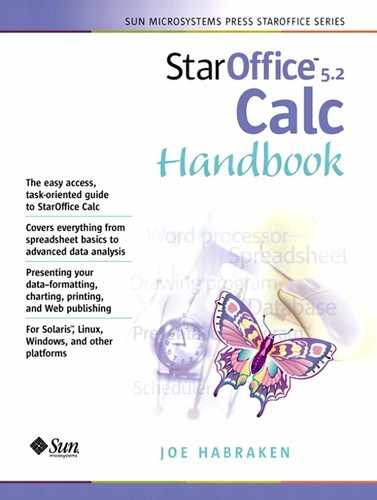Using the Explorer
Another extremely useful tool is the StarOffice Explorer. The Explorer provides you with an easy way to view, organize, and otherwise manipulate files and folders on your computer (or network) without leaving the StarOffice Desktop or closing documents that you are currently working on. The Explorer also provides you with easy access to your Web site bookmarks, and you can use the Explorer to organize your StarOffice documents and other files into compartments called groups, providing you with a very straightforward system for keeping your projects and other work in some semblance of order (everybody misplaces files on their computer and StarOffice groups can really help keep you organized).
To open the Explorer, click the View menu, then click Explorer. The Explorer can be used to view drives, folders, and files in the Desktop workspace, or it can also be used when you already have a file open such as a StarOffice Calc spreadsheet. Figure 1.5 shows the Explorer open on the StarOffice Desktop with an open Calc spreadsheet on the Desktop workspace.
Figure 1.5. The Explorer lets you access and manipulate files and folders while you work in your StarOffice documents.

When you work in the Explorer, you have a choice of displaying drives, folders, and files as large icons, small icons, or in a hierarchical fashion. The default is hierarchical, which places plus symbols next to containers such as folders that contain other folders and files. Let's take a look at how the hierarchical view works.
For example, let's say you want to view the contents of a particular folder on your hard drive while working on a Calc spreadsheet. Just click the plus symbol (+) at the left of the Workplace icon in the Explorer pane (the Workplace is the container that provides access to your computer's drives and directories). The Workplace icon will expand, providing you with access to your computer's hard drives and network drives (if you are connected to a network). Click the plus symbol (+) next to any of the drives to view their contents. You can then expand folders on the drive to view the files held there. At any time, you can close a particular drive or folder that you have expanded by clicking the minus (-) sign at the left of the drive or folder.
Once you find a particular file, you can open it by clicking on the file. The file will open in the StarOffice workspace. However, you'll find that your previous work, your Calc spreadsheet, has disappeared. No problem, the file is still open; all you have to do is click the icon for the document. For example, click the icon for the Calc spreadsheet on the taskbar to return to that document window (you can also quickly return to the previous file by clicking the Back button on the Function toolbar).
If you find that you would rather view the various Explorer drives, folders, and files using large icons or small icons (rather than the hierarchical view), right-click the Explorer button and use the context menu that appears to select your view.
Note
The Explorer is also very useful when the Desktop workspace is empty. Selected drives or folders in the Explorer will have their contents shown in the workspace window. You can double-click on folders to open them and double-click on files to load them into the workspace area.
If you find that the Explorer is in the way while you are working on a particular document in the workspace, just click the Hide button on the Explorer (the small triangle at the upper right of the Explorer pane) and the Explorer will collapse. To reopen the Explorer, click the Show button (it's the same small triangle, but now it points to the right) and the Explorer pane will expand.
The Explorer is also a “dockable” window. Place your mouse anywhere on the Explorer window, hold down the Ctrl key, and then double-click. The Explorer window will appear with a title bar that allows you to drag the window anywhere onto the Desktop. You can also size the Explorer window with your mouse as needed by placing the mouse on any of the Explorer window's borders and then just dragging to change the width or height of the window as needed.
You can also “collapse” the Explorer window when you need more room for your documents on the Desktop. Click the Hide button (the left-pointing triangle at the top right of the Explorer window). To reopen the Explorer window, click the button again, which is now labeled Show.
Note
Whenever you would like information on a toolbar button or parts of a particular window such as the Explorer, place your mouse on the item. You will receive a tip associated with the icon or button. If you would like extended tips, click the Help menu and select Extended Tips for more information on these screen elements.
